Desalting and Buffer Exchange for Affinity Chromatography of Antibodies
General considerations
Desalting at laboratory scale is a well-proven, simple, and fast method that will rapidly remove low molecular weight contaminants at the same time as transferring the sample into the desired buffer in a single step.
Cytiva offers a range of prepacked chromatography columns and 96-well filter plates that can be used manually, together with a chromatography system, or in high-throughput applications (Table 2.8). These products contain Sephadex™ G-25, a size exclusion chromatography (SEC, also known as gel filtration) medium that allows effective removal of low molecular weight substances from antibodies with a molecular weight > 5000.
Use desalting/buffer exchange when needed, before and/or between purification steps. Remember that each extra step can reduce yield and that desalting often dilutes the sample (centrifugation protocols do not dilute samples).
Remove salts and other low molecular compounds from proteins with molecular weight > 5000.
Sample volumes of up to 30% of the total volume of the desalting column can be processed. The high speed and capacity of the separation allows even relatively large sample volumes to be processed rapidly and efficiently in the laboratory. Sample concentration does not influence the separation as long as the concentration of antibodies does not exceed approximately 70 mg/mL when using normal aqueous buffers, and provided that the antibody is stable and soluble at the concentration used.
When desalting is the first chromatography step, the sample should first be clarified; centrifugation and/or filtration are recommended.
Use 100 mM ammonium acetate or 100 mM ammonium hydrogen carbonate if volatile buffers are required.
Desalting provides several advantages over dialysis, which is generally a slow technique requiring large volumes of buffer and carries the risk of losing material during handling.
At laboratory scale, the buffer exchange and desalting step can be omitted when samples are reasonably clean after filtration or centrifugation. For AC or IEX, it might be sufficient to adjust the pH of the sample and, if necessary, the ionic strength of the sample.
Buffer exchange can sometimes be avoided by dilution to reduce ion strength, addition of ammonium sulfate before HIC or titration to adjust pH.
Small-scale desalting of samples
For sample volumes ranging from 0.2 mL to 2.5 mL, it is possible to run multiple samples in parallel with PD-10 Desalting Columns, PD MidiTrap™ G-25, and PD MiniTrap™ G-25 gravity columns. Two different protocols are available for these gravity columns: one for manual use on the laboratory bench; and one for use together with a standard centrifuge in combination with a Spin Adapter.
For smaller sample volumes in the range of 100 to 180 µL, multiple samples can be run on PD SpinTrap™ G-25 spin columns together with a microcentrifuge or PD MultiTrap™ G-25 96-well plate using centrifugation for extraction (Figure 2.2).
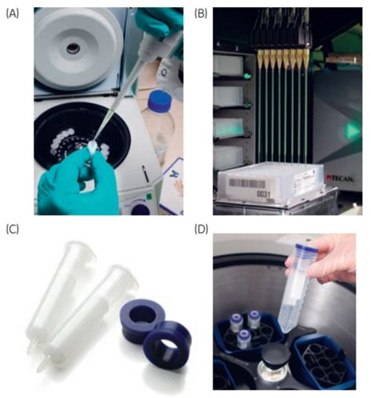
Figure 2.2.(A) PD SpinTrap™ G-25 sample preparation. (B) PD MultiTrap™ G-25 sample automated preparation in a robotic system. (C and D) Spin Adapters are used together with PD-10 Desalting Columns, PD MidiTrap™ G-25, and PD MiniTrap™ G-25 in a standard centrifuge.
Desalting larger sample volumes using HiTrap® and HiPrep™ columns
Connect up to three HiTrap® Desalting columns in series to increase the sample volume capacity, for example, two columns allow a sample volume of 3 mL; three columns allow a sample volume of 4.5 mL (Table 2.8).
Connect up to four HiPrep™ 26/10 Desalting columns in series to increase the sample volume capacity, for example, two columns allow a sample volume of 30 mL; four columns allow a sample volume of 60 mL. Even with four columns in series, the sample can be processed in 20 to 30 min (Table 2.8).
Buffer preparation
For substances carrying charged groups, an eluent containing a buffer salt is recommended. A salt concentration of at least 150 mM is recommended to prevent possible ionic interactions with the medium. Sodium chloride is often used for this purpose. Often a buffer with 25 to 50 mM concentration of the buffering substance is sufficient.
At salt concentrations above 1 M, hydrophobic substances can be retarded or bind to the medium. At even higher salt concentrations (> 1.5 M ammonium sulfate), the column packing shrinks.
Sample preparation
Sample concentration does not influence the separation as long as the viscosity does not differ by more than a factor of 1.5 from that of the buffer used. This corresponds to a maximum concentration of 70 mg/mL for proteins, when normal, aqueous buffers are used.
The sample should be fully solubilized. Centrifuge or filter (0.45 µM filter) immediately before loading to remove particulate material if necessary.
Protein solubility often depends on pH and/or ionic strength (salt concentration), and the exchange of buffer can therefore result in precipitation of the protein. Also, protein activity can be lost if the change of pH takes it outside of the range where the protein is active.
The protocols in the following sections describe desalting and buffer exchange using different formats of prepacked columns.
Manual desalting with HiTrap® Columns
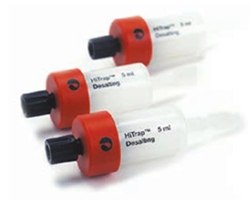
Figure 2.3.HiTrap® Desalting column allows efficient, easy-to-perform group separations with a syringe, pump, or chromatography system.
HiTrap® Desalting is a 5 mL column (Figure 2.3) packed with the tried-and-tested SEC medium, Sephadex™ G-25 Superfine. The medium is based on cross-linked dextran beads that allow excellent resolution and high flow rates. The fractionation range for globular proteins is between Mr 1 000 and 5 000, with an exclusion limit of approximately Mr 5 000. This ensures group separations of proteins/peptides larger than Mr 5 000 from molecules with a molecular weight less than Mr 1 000.
HiTrap® Desalting can be used with aqueous solutions in the pH range 2 to 13. The prepacked medium is stable in all commonly used buffers, solutions of urea (8 M), guanidine hydrochloride (6 M), and all nonionic and ionic detergents. Lower alcohols (methanol, ethanol, propanol) can be used in the buffer or the sample, but we recommend that the concentration be kept below 25% v/v. Prolonged exposure (hours) to pH below 2 or above 13, or to oxidizing agents, should be avoided.
The recommended range of sample volumes is 0.1 to 1.5 mL when complete removal of low molecular weight components is desired. The separation is not affected by the flow rate, in the range of 1 to 10 mL/min. The maximum recommended flow rate is 15 mL/min. Separations are easily performed with a syringe, pump, or chromatography system. Up to three columns can be connected in series, allowing larger sample volumes to be handled.
Figure 2.4 shows a typical desalting and buffer exchange separation achieved using HiTrap® Desalting and monitored by following changes in UV absorption and conductivity.

Figure 2.4.Highly efficient desalting in 30 s using HiTrap® Desalting.
To avoid cross-contamination, only use the column with the same type of sample.
Column equilibration
- Fill the syringe or pump tubing with buffer. Remove the stopper. To avoid introducing air into the column, connect the column “drop to drop” to either the syringe (via the connector) or to the pump tubing.
- Remove the snap-off end at the column outlet.
- Wash the column with 25 mL of buffer at 5 mL/min to completely remove the storage buffer, which contains 20% ethanol*. If air is trapped in the column, wash with degassed buffer until the air disappears. Air introduced into the column by accident during sample application does not influence the separation.
* 5 mL/min corresponds to approximately 120 drops/min when using a HiTrap® 5 mL column.
Manual desalting using a syringe
- To operate the column with a syringe, connect the syringe to the column using the supplied connector.
- Equilibrate the column, see previous page Column equilibration.
- Apply the sample using a 2 to 5 mL syringe at a flow rate between 1 and 10 mL/min. Discard the liquid eluted from the column. If the sample volume is less than 1.5 mL, change to buffer and proceed with the injection until a total of 1.5 mL has been eluted. Discard the eluted liquid.
- Elute the protein with the appropriate volume selected from Table 2.9. Collect the desalted protein.
The maximum recommended sample volume when using one HiTrap® Desalting 5 mL column is 1.5 mL, Table 2.9. , Table 2.8 for information on application of smaller sample volumes.
The void volume of the column is 1.5 mL. High molecular weight components elute between 1.5 and 4.5 mL, depending on the sample volume. Low molecular weight components start to elute after 3.5 mL.
Certain types of molecules, such as small heterocyclic or homocyclic aromatic compounds (purines, pyrimidines, dyes) can interact with Sephadex™ and are therefore eluted later than expected. Larger sample volumes can be used in these cases, but the separation has to be optimized for each type of contaminating compound.
Desalting using a pump
- Equilibrate the column: see Column equilibration on the previous page.
- Apply up to 1.5 mL of sample. Monitor the effluent from the column with a UV monitor and/or a conductivity monitor. Keep the flow rate in range 1 to 10 mL/min. Collect fractions.
- Elute the column with approximately 10 mL of buffer before applying the next sample. Collect fractions.
Automated desalting with HiTrap® Desalting columns on ÄKTAprime plus
ÄKTAprime plus contains preprogrammed templates for individual HiTrap® Desalting and HiPrep™ Desalting 26/10 columns. The procedure below uses a HiTrap® Desalting 5 mL column.
Buffer preparation
Equilibration buffer (port A1): Prepare at least 500 mL of the required buffer
Water and chemicals used for buffer preparation should be of high purity. Filter buffers through a 0.45 µM filter before use.
Sample preparation
Pass the sample through a 0.45 µM filter.
The maximum recommended sample volume is 1.5 mL.
Preparing ÄKTAprime plus
- Place the inlet tubing from port A (port valve) and port B (2-port valve) in to the buffer.
- Place the three brown waste tubings in the waste flask.
- Connect the column between port 1 on the injection valve (7-port valve) and the UV flow cell.
- Fill the fraction collector rack with 18 mm tubes (minimum 20) and position the white plate on the fractionation arm against the first tube.
- Connect a sample loop large enough for your sample between ports 2 and 6 on the injection valve. Use a syringe to manually fill the loop.
Note: If a Superloop™ is needed, additional information is supplied in the instructions for use.Enter the sample volume and press OK to start the template.
Once the system is prepared, the remaining steps (under Selecting Application Template and starting the method below) will be performed automatically.
Selecting Application Template and starting the method
- Check the communication to PrimeView™. At the lower right corner of the screen the text Controlled By: prime should be displayed.
- Use the arrow and OK buttons to navigate in the menu tree until you find Desalting HiTrap® Desalting.

3. Enter the sample volume and press OK to start the template.
Figure 2.5 shows a typical result for desalting of a normal sized globular protein using HiTrap® Desalting column and ÄKTAprime plus chromatography system. The result shown in this Figure would also be expected in buffer exchange of antibodies. The UV and conductivity traces enable the appropriate desalted fractions to be pooled.

Figure 2.5.Typical desalting of a normal sized globular protein using a chromatography system.
Scaling up desalting from HiTrap® to HiPrep™
For separation of sample volumes larger than 1.5 mL, or to increase the resolution between high and low molecular weight components, up to three HiTrap® Desalting columns can easily be connected in series (Table 2.8). For syringe operations, the volumes suggested in Table 2.8 should be increased proportionally and the recommended flow rate maintained. The dilution of the sample is dependent on the sample volume and the number of columns used in series. Lower dilution factors than those proposed in Table 2.8 can be obtained, but the elution volumes have to be optimized for each combination of sample volume and number of columns in series. The backpressure for each column is approximately 0.25 bar at 10 mL/min.
HiPrep™ 26/10 Desalting is packed with Sephadex™ G-25 Fine. It provides group separation of high (Mr > 5 000) from low molecular weight substances (Mr < 1 000), allowing reliable and reproducible desalting and buffer exchange with sample sizes of 15 mL per column. Two to four columns can be used in series (Table 2.8) for sample volumes of of 30 to 60 mL (Figure 2.6).
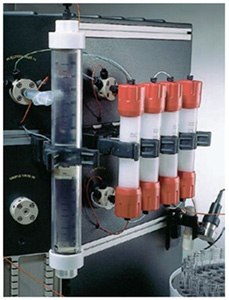
Figure 2.6.A 60 mL sample volume can be run on four HiPrep™ 26/10 Desalting columns connected in series.
Automated buffer exchange on HiPrep™ 26/10 Desalting with ÄKTAprime plus
Buffer preparation
Equilibration buffer (port A1): 20 mM sodium phosphate, 150 mM sodium chloride, pH 7.0. Prepare at least 500 mL of eluent
Sample preparation
Water and chemicals used for buffer preparation should be of high purity. Filter buffers through a 0.45 µm filter before use.
Pass the sample through a 0.45 µm filter.
The maximum recommended sample volume is 15 mL.
- Place the inlet tubing from port A (8-port valve) and port B (2-port valve) in the buffer.
- Place the three brown waste tubings in the waste flask.
- Connect the column between port 1 on the injection valve (7-port valve) and the UV flow cell.
- Fill the fraction collector rack with 18 mm tubes (minimum 25) and position the white plate on the fractionation arm against the first tube.
- Connect a sample loop large enough for your sample between port 2 and 6 on the injection valve. Use a syringe to manually fill the loop.
Note: If a Superloop is needed, additional information is supplied in the instructions for the product.
Once the system is prepared, the remaining steps (under Selecting Application Template and starting the method described earlier) will be performed automatically.
Selecting Application Template and starting the method
- Check the communication to PrimeView. At the lower right corner of the screen the text Controlled By: prime should be displayed.
- Use the arrow and OK buttons to move in the menu tree until you find Desalting HiPrep™ Desalting.

3. Enter the sample volume and press OK to start the template.
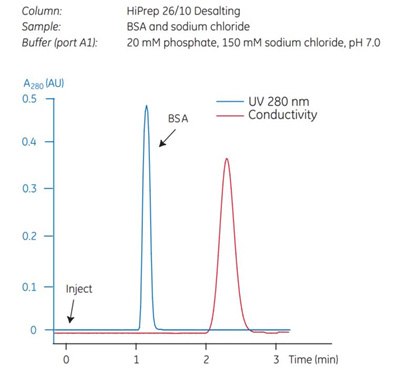
Figure 2.7.A typical desalting of BSA using a chromatography system.
Small-scale desalting and buffer exchange with PD desalting columns
PD-10 Desalting Columns, PD MidiTrap™ G-25, PD MiniTrap™ G-25, PD SpinTrap™ G-25, and PD MultiTrap™ G-25 columns and 96-well filter plates are prepacked with Sephadex™ G-25 Medium for group separation of high (Mr > 5 000) from low molecular weight substances (Mr < 1 000) by desalting and buffer exchange.
PD products address the need for flexible, small-scale preparation of protein sample or other biomolecules prior to downstream analytical techniques such as gel electrophoresis, liquid chromatography (LC), liquid chromatography-mass spectrometry (LC-MS), and mass spectrometry (MS). This collection of columns and plates covers the sample volume range from 70 µL to 2.5 mL and supports processing multiple samples in parallel. PD-10 Desalting Columns, PD MidiTrap™ G-25, and PD MiniTrap™ G-25, are also optimized to enable centrifugation, which results in no dilution of the eluted sample.
PD SpinTrap™ G-25
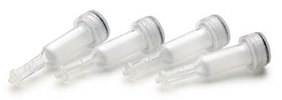
Figure 2.8.PD SpinTrap™ G-25 columns are single-use columns for rapid desalting and buffer exchange of biomolecules with a molecular weight > 5000.
PD SpinTrap™ G-25 is a single-use spin column that is designed for rapid, highly reproducible desalting and buffer exchange of 100 to 180 µL sample using a standard microcentrifuge (Figures 2.2 A and 2.8). The columns provide highly reproducible, parallel desalting/buffer exchange and cleanup of protein samples without sample dilution.
Each pack of PD SpinTrap™ G-25 contains prepacked columns and collection tubes for 50 preparations.
Buffer
Equilibration buffer: Appropriate for the application
Desalting procedure
1. Suspend the medium by vortexing. Loosen screw cap lid and remove bottom closure using the plastic bottom cap removal tool.
2. Place the column in an appropriately sized collection tube and remove the storage solution by centrifugation for 1 min at 800 × g.
3. Equilibrate by adding 400 µL equilibration buffer and centrifuge for 1 min at 800 × g. Discard the flowthrough and replace the collection tube. Repeat this procedure four times.
To ensure optimal results, it is critical to equilibrate the spin column with 1.5 mL of equilibration buffer in total to completely remove the storage solution.
4. Replace the used collection tube with a new clean collection tube for sample collection.
5. Apply 100 to 180 µL sample slowly to the middle of the prepacked column.
6. Elute by centrifugation at 800 x g for 2 min.
For desalting larger sample volumes, use larger scale PD cleanup products or HiTrap® and HiPrep™ columns, Table 2.8. For desalting of multiple samples, use PD MultiTrap™ G-25.
Recovery is dependent on type of protein or other biomolecule. Typically, recovery is in the range of 70% to 90%. Concentration of the sample can improve recovery. Recovery can be improved for sample volumes less than 140 µL by adding 40 µL equilibration buffer after the sample has fully absorbed into the column bed.
PD MultiTrap™ G-25
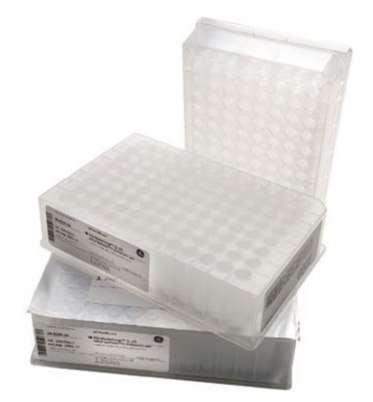
Figure 2.9.PD MultiTrap™ G-25 96-well plates offer rapid, highly reproducible cleanup of biomolecules with a molecular weight > 5000.
PD MultiTrap™ G-25 96-well plates are designed for high-throughput desalting, buffer exchange, and cleanup of proteins, with high reproducibility well-to-well and plate-to-plate (Figure 2.9). Using the 96-well plates, multiple samples can be run conveniently and reproducibly in parallel (Figure 2.10). PD MultiTrap™ G-25 can be operated manually or in automated mode using a robotic system together with a centrifuge to desalt or buffer exchange sample volumes ranging from 70 to 130 µL.
The wells are prepacked with Sephadex™ G-25 Medium, an SEC medium that allows effective removal of low molecular weight substances from biomolecules with a molecular weight > 5000.
Each pack of PD MultiTrap™ G-25 contains four prepacked 96-well plates, allowing desalting or buffer exchange of up to 384 samples. Convenient collection plates (five per pack) are available separately.

Figure 2.10.Removal of sodium chloride from BSA on a PD MultiTrap™ G-25 96-well plate showed highly reproducible results. The average desalting capacity was 93% and the well-to-well variation was 1% (relative standard deviation).
Centrifugation protocol
Buffer
Equilibration buffer: Appropriate for the application
Desalting procedure
1. Suspend the medium by gently shaking the plate upside down. Remove top and bottom seals and place plate on the collection plate.
2. Remove the storage solution by centrifugation for 1 min at 800 × g.
3. Equilibrate by adding 300 µL equilibration buffer per well. Centrifuge for 1 min at 800 × g. Discard the flowthrough and replace the collection plate. Repeat this procedure four times.
To ensure optimal results, it is critical to equilibrate each well with 1.5 mL of equilibration buffer in total to completely remove the storage solution.
4. Replace the used collection plate with a new, clean collection plate for sample collection.
5. Apply 70 to 130 µL of sample to the middle of the prepacked wells.
6. Elute by centrifugation at 800 × g for 2 min.
For desalting larger sample volumes, use larger scale PD cleanup products or HiTrap® and HiPrep™ columns, Table 2.8.
Recovery is dependent on type of protein or other biomolecule. Typically, the recovery is in the range of 70% to 90%. Concentration of the sample can improve recovery. Recovery can be improved for sample volumes less than 100 µL by adding 30 µL equilibration buffer after the sample has fully absorbed into the column bed.
PD MiniTrap™ G-25
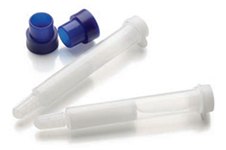
Figure 2.11.PD MiniTrap™ G-25 is a prepacked column for cleanup of proteins with a molecular weight > 5000 in sample volumes up to 500 µL.
PD MiniTrap™ G-25 is designed for convenient desalting and buffer exchange of 100 to 500 µL volume of protein sample (Figure 2.11). The columns are prepacked with Sephadex™ G-25 Medium, an SEC medium that allows effective removal of low molecular weight substances from proteins with a molecular weight > 5000. These columns provide an excellent alternative to PD SpinTrap™ G-25 columns on account of the increased sample volume capacity.
For increased flexibility, the product has two alternative application protocols, using either gravity or centrifugation. The gravity protocol allows simple cleanup of multiple samples in parallel without the need for a purification system. With the centrufigation protocol, samples are run in a standard centrifuge with minimal dilution of the eluted sample.
Each pack of PD MiniTrap™ G-25 contains 50 prepacked columns and four adapters that are required when using the centrifugation protocol.
Gravity protocol
Buffer
Equilibration buffer: Appropriate for the application
Desalting procedure
1. Remove the top cap and pour off the column storage solution. Remove the bottom cap.
2. Fill the column with equilibration buffer and allow the equilibration buffer to enter the packed bed completely. Repeat twice and discard the flowthrough.
To ensure optimal results, it is critical to equilibrate the column with 8 mL of equilibration buffer in total to completely remove the storage solution.
3. Add 100 to 500 µL of sample to the column. For sample volumes lower than 500 µL, add equilibration buffer to adjust the volume up to 500 µL after the sample has entered the packed bed completely.
4. Allow the sample and equilibration buffer to enter the packed bed completely. Discard the flowthrough.
5. Place a test tube for sample collection under the column and elute with 1 mL buffer. Collect the desalted sample.
For desalting larger sample volumes, use HiTrap® and HiPrep™ columns, Table 2.8.
Recovery is dependent on type of protein. Typically, recovery is in the range of 70% to 90%. Concentration of the sample can improve recovery. Recovery and desalting capacity are higher when using gravity flow compared with centrifugation.
A typical result for desalting of a protein is shown in Figure 2.12. Although the desalted protein shown in the Figure is BSA, a similar result would be expected in the desalting of antibodies using PD MiniTrap™ G-25.

Figure 2.12.Removal of sodium chloride from BSA using the gravity protocol. The protein recovery was 95%.
Centrifugation protocol
Buffer
Equilibration buffer: Appropriate for the application
Desalting procedure
1. Remove the top cap and pour off the column storage solution.
2. Remove the top filter using forceps. Remove the bottom cap.
3. Place the PD MiniTrap™ G-25 into a 15 mL collection tube and connect the supplied column adapter to the top of the tube.
4. Fill the column with equilibration buffer and allow the equilibration buffer to enter the packed bed completely. Repeat and discard the flowthrough.
5. Fill the column with equilibration buffer again and centrifuge at 1000 x g for 2 min and discard the flowthrough.
To ensure optimal results, it is critical to equilibrate the column with 8 mL of equilibration buffer in total (steps 4 and 5) to completely remove the storage solution.
6. Add 200 to 500 µL of sample slowly to the middle of the packed bed.
7. Place the PD MiniTrap™ G-25 into a new 15 mL collection tube.
8. Elute by centrifugation 1000 x g for 2 min and collect the eluate.
For desalting larger sample volumes, use HiTrap® and HiPrep™ columns, Table 2.8.
Recovery is dependent on type of protein. Typically, recovery is in the range of 70% to 90%. Concentration of the sample can improve recovery. Recovery and desalting capacity are higher using gravity flow compared with centrifugation.
PD MidiTrap™ G-25
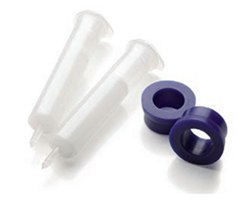
Figure 2.13.PD MidiTrap™ G-25 is a prepacked column for cleanup of proteins with a molecular weight > 5000 in sample volumes up to 1 mL.
PD MidiTrap™ G-25 is designed for convenient desalting and buffer exchange of 0.5 to 1.0 mL volume of protein sample (Figure 2.13). The columns are prepacked with Sephadex™ G-25 Medium, an SEC medium that allows effective removal of low molecular weight substances from proteins with a molecular weight > 5000. These columns provide an excellent alternative to PD MiniTrap™ G-25 columns on account of the increased sample volume capacity.
For increased flexibility, the product has two alternative application protocols, using either gravity or centrifugation. The gravity protocol allows simple cleanup of multiple samples in parallel without the need for a purification system. With the centrifugation protocol, samples are run in a standard centrifuge with minimal dilution of the eluted sample.
Each pack of PD MidiTrap™ G-25 contains 50 prepacked columns and four adapters that are required when using the centrifugation protocol.
Centrifugation protocol
Buffer
Equilibration buffer: Appropriate for the application
Desalting procedure
1. Remove the top cap and pour off the column storage solution.
2. Remove the top filter using forceps. Remove the bottom cap.
3. Place the PD MidiTrap™ G-25 into a 50 mL collection tube and connect the supplied column adapter to the top of the tube.
4. Fill the column with equilibration buffer and allow the equilibration buffer to enter the packed bed completely. Repeat and discard the flowthrough.
5. Fill the column with equilibration buffer again and centrifuge at 1000 x g for 2 min and discard the flowthrough.
To ensure optimal results, it is critical to equilibrate the column with 15 mL of equilibration buffer in total (steps 4 and 5) to completely remove the storage solution.
6. Add 0.75 to 1.0 mL of sample slowly to the middle of the packed bed.
7. Place the PD MidiTrap™ G-25 into a new 50 mL collection tube.
8. Elute by centrifugation 1000 x g for 2 min and collect the eluate.
For desalting larger sample volumes, use HiTrap® and HiPrep™ columns, Table 2.8.
Recovery is dependent on type of protein. Typically, recovery is in the range of 70% to 90%. Concentration of the sample can improve recovery. Recovery and desalting capacity are higher using gravity flow compared with centrifugation.
Disposable PD-10 Desalting Columns
PD-10 Desalting Columns are designed for convenient desalting and buffer exchange of 1.0 to 2.5 mL volume of protein sample. The columns are prepacked with Sephadex™ G-25 Medium, an SEC medium that allows effective removal of low molecular weight substances from proteins with a molecular weight > 5000. These columns provide an excellent alternative to PD MidiTrap™ G-25 columns on account of the increased sample volume capacity.
For increased flexibility, the product has two alternative application protocols, using either gravity or centrifugation. The gravity protocol allows simple cleanup of multiple samples in parallel without the need for a purification system. Using the centrifugation protocol, samples are run in a standard centrifuge with minimal dilution of the eluted sample.
Each pack of PD-10 Desalting Columns contains 30 prepacked columns. To simplify the use of PD-10 Desalting Columns with the gravity protocol, LabMate PD-10 Buffer Reservoir may be used. Using the buffer reservoir, wash and equilibration buffers can be applied in one step.
A typical separation is shown in Figure 2.14. Although the Figure shows a typical desalting of albumin, this would be an expected result for the desalting of antibodies.

Figure 2.14.Removal of sodium chloride from albumin solution. A PD-10 Desalting column was equilibrated with distilled water. The sample contained human serum albumin (25 mg) dissolved in 2.5 mL of 500 mM sodium chloride solution. A total of 23.8 mg albumin was recovered in 3.5 mL eluent corresponding to a yield of 95.3% (between arrows). Initial total salt content of sample before desalting was 2%.
Gravity protocol
Buffer
Equilibration buffer: Appropriate for the application
Desalting procedure
- Cut off bottom tip, remove top cap, and pour off excess liquid.
- If available, mount the LabMate Buffer Reservoir on top of the PD-10 Desalting column and place the columns in the PD-10 Desalting Workmate.
- Equilibrate the column with approximately 25 mL of buffer. Discard the flowthrough (use the plastic tray to collect flowthrough).
To ensure optimal results, it is critical to equilibrate the column with 25 mL of equilibration buffer in total to completely remove the storage solution.
- Add sample of a total volume of 2.5 mL. If the sample is less than 2.5 mL, add buffer until the total volume of 2.5 mL is achieved. Discard the flowthrough.
- Elute with 3.5 mL of buffer and collect the flowthrough.
For desalting larger sample volumes, use HiTrap® and HiPrep™ columns, Table 2.8.
Recovery is dependent on type of protein. Typically, recovery is in the range of 70% to 90%. Concentration of the sample can improve recovery. Recovery and desalting capacity are higher using gravity flow compared with centrifugation.
Centrifugation protocol
Buffer
Equilibration buffer: Appropriate for the application
Desalting procedure
1. Remove the top cap and pour off the column storage solution.
2. Remove the top filter using forceps. Remove the bottom cap.
3. Place the PD-10 Desalting Column into a 50 mL collection tube and connect the supplied column adapter to the top of the tube.
4. Fill the column with equilibration buffer and allow the equilibration buffer to enter the packed bed completely. Repeat three times, discarding the flowthrough each time.
5. Fill the column with equilibration buffer again and centrifuge at 1000 x g for 2 min and discard the flowthrough.
To ensure optimal results, it is critical to equilibrate the column with 25 mL of equilibration buffer in total (steps 4 and 5) to completely remove the storage solution.
6. Add 1.75 to 2.5 mL of sample slowly to the middle of the packed bed.
7. Place the PD-10 Desalting column into a new 50 mL collection tube.
8. Elute by centrifugation 1000 x g for 2 min and collect the eluate.
For desalting larger sample volumes, use HiTrap® and HiPrep™ columns, Table 2.8.
Recovery is dependent on type of protein. Typically, recovery is in the range of 70% to 90%. Concentration of the sample can improve recovery. Recovery and desalting capacity are higher using gravity flow compared with centrifugation.
Materials
To continue reading please sign in or create an account.
Don't Have An Account?